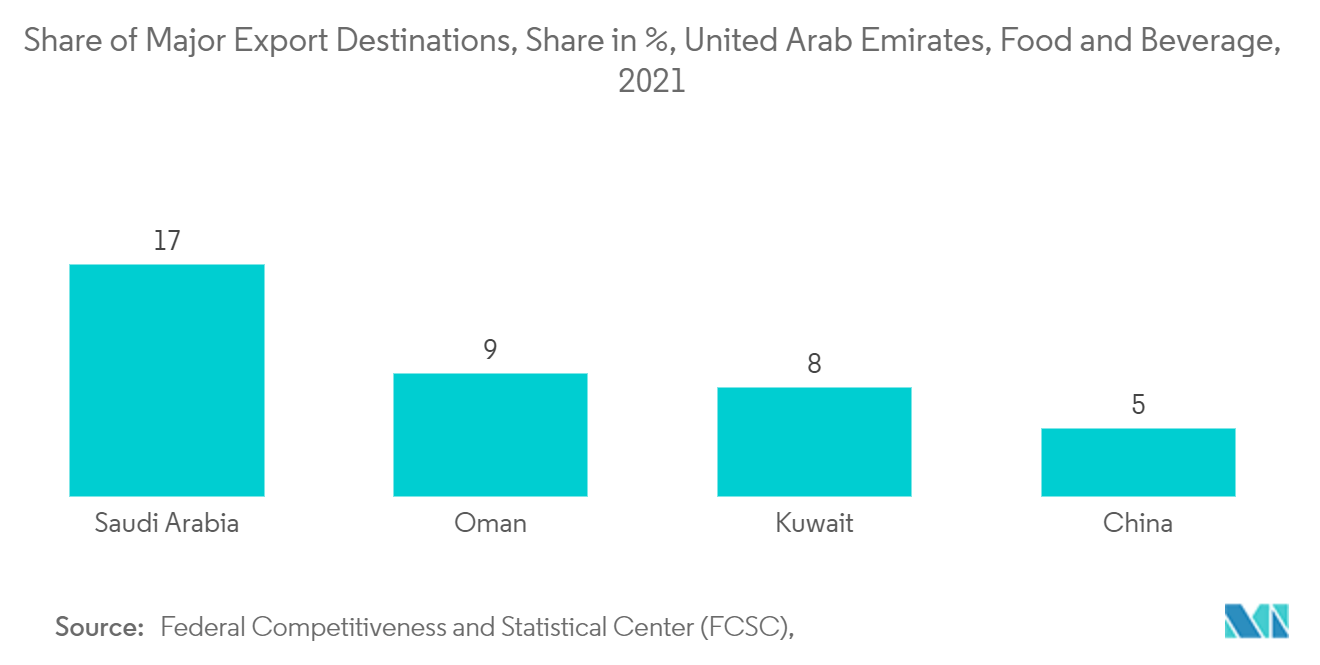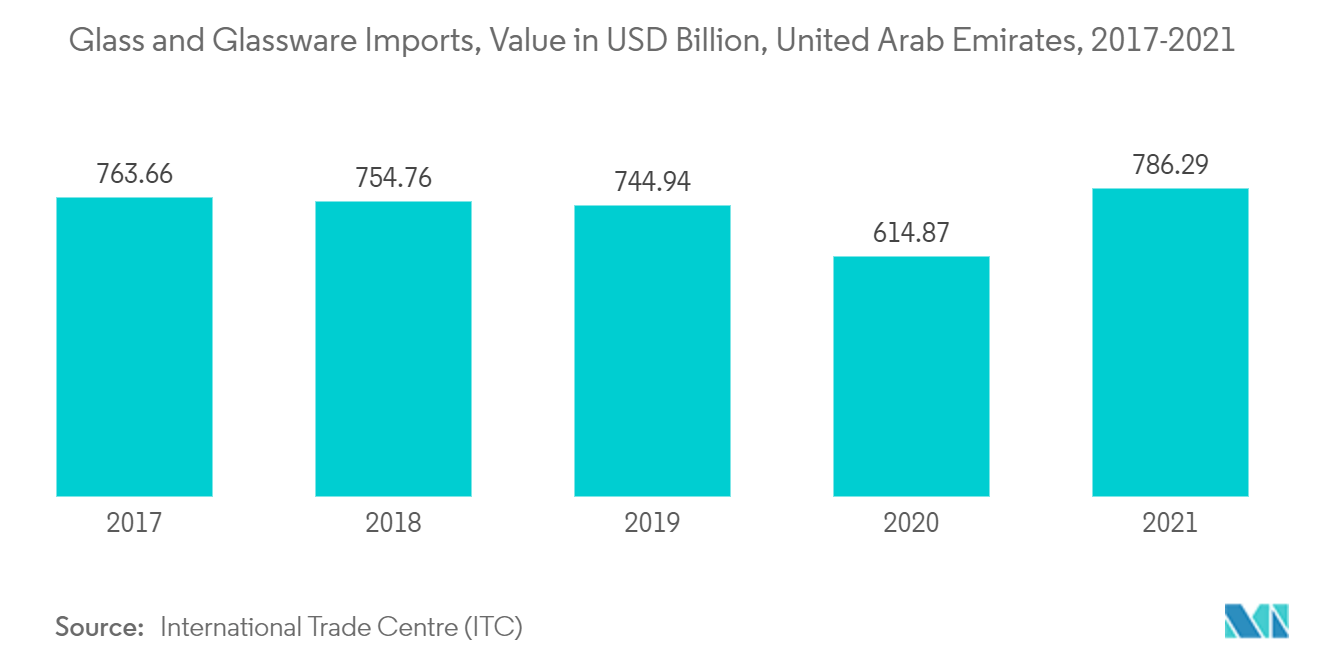Market Trends of UAE Container Glass Industry
This section covers the major market trends shaping the UAE Container Glass Market according to our research experts:
Beverages Segment to Hold Significant Market Share
- The natural flavor of the drink is preserved without affecting the quality due to the versatility of glass as a packaging material. According to the DCCI's (Dubai Chamber of Commerce and Industry) report, online F&B sales are forecasted to reach USD 619 million by 2025. Saudi Arabia, Oman, and Iraq have the biggest potential for beverage exports from the United Arab Emirates. This element influences market demand.
- According to a report from the DCCI (Dubai Chamber of Commerce and Industry), the food and beverage trade in the UAE progressively increased to approximately USD 20 billion in the first nine months of 2021, driven by rising demand and enhanced efforts to improve food security and diversify food imports. From January through September 2021, imports valued at USD 12.8 billion made up most of the UAE's F&B trade. Exports came in second at USD 4.1 billion, while re-exports came in third at USD 1.1 billion. The reports include dairy products which hold 10% of the imports, which could enhance container glass demand in the region.
- Due to the region's adherence to Islamic Sharia Law, which forbids the use or drinking of alcohol for religious purposes, alcohol is exceedingly scarce, if not completely unavailable.
- Additionally, the market of non-alcoholic beverages includes packaging options for juice, soda, milk, ready-to-drink coffee and tea, carbonated beverages, sports and energy drinks, and ready-to-drink coffee and tea. As people become increasingly interested in various flavor alternatives for their health and wellness, flavored drinks are becoming more popular.
- Additionally, consumers are switching to smaller-sized bottles. The demand from consumers for items with price-sensitive container glass packaging also rises with the expectation that this trend will last throughout the forecast period.
- However, the non-alcoholic beverage industry's use of plastic is a fierce competitor in the market for glass containers. However, because they offer a practical packaging solution, returnable glass bottles continue to be a crucial method of product distribution for all significant businesses in the non-alcoholic beverage sector.
- As consumers worldwide favor zero percent alternatives to alcoholic beverages, non-alcoholic beverage businesses are developing to capture their hearts, minds, and market share in the UAE. For instance, in August 2022, Dusit Thani Dubai launched NoLo, the city's first bar without alcohol. With one significant distinction, NoLo offers the same experience. Instead of alcohol, the glasses are filled with creative and well-made craft 0% cocktails.
- Moreover, due to its sustainability attributes, the trend has aided glass packaging options in maintaining their market share and growing acceptance. In addition, during the past five years, technological developments have lowered the weight of glass packaging by 30% while maintaining the same strength. The trend has significantly increased demand for glass bottles and containers, particularly in the non-alcoholic beverage industry.

Pharmaceutical Segment is Expected to Grow Significantly
- Middle Eastern nations rely heavily on pharmaceuticals and medical supplies. The United Arab Emirates has similar geographic and climatic characteristics and adheres to the same trend. In October 2021, the UAE passed its highest government budget, at AED290 billion, for 2022-2026. The AED 4.9 billion (8.4% of the total general budget) allocated to health care and community protection in 2022 will provide the highest health care services. Due to increased spending to tackle the COVID-19 pandemic, the UAE government boosted its healthcare budget to USD 1.4 billion and 8.1% of the entire budget in 2021.
- The pharmaceutical sector uses amber bottles extensively because of light and UV concerns. For example, amber-colored bottles are required for many medications and offer the best protection against all visible light wavelengths.
- Government programs in the region have also helped to advance the market. A proper recycling chain is established with the help of government and supply chain participants, which may benefit the market's vendors and is anticipated to reduce costs.
- For instance, the UAE Ministry of Economy gave the business and investor community full authority under the CEPA agreement in April 2022. If import levies were eliminated or significantly reduced, trade volumes would take five years to increase from USD 40 billion to USD 100 billion. However, the Comprehensive Economic Partnership Agreement's (CEPA) full benefits will go beyond trade to include investments, the inflow and outflow of technological transfers, and a boost for the startup community.
- Additionally, patented pharmaceuticals account for the most percentage of sales in the UAE. The government of the UAE has introduced two innovation-focused national plans, the Abu Dhabi Vision 2030 and the Dubai Industrial Strategy 2030, which both prioritize the development of the biopharmaceutical industry. Therefore, it suggests that the MoH aims to collaborate with local businesses to strengthen the licensing rules for current medication producers, which will help the market growth throughout the forecast period.
- Further, generic drug adoption is rising in the region and has the highest adoption of glass packing in the area. According to the MOHAP (Emirati Ministry of Health and Prevention), in 2021, 6,176 generic medications and pharmaceuticals were available in the UAE. Drugs and medical supplies are produced in 16 plants across the nation. Because generic medicines cost 60 percent less than branded medications, they make it possible for patients to obtain appropriate and affordable care.


